
Europe and Mediterranean: Rhine Holiday Markets Cruise
Uniworld Boutique River Cruises
A festive journey destined to delight travelers of all ages. Switzerland, France and Germany provide the backdrop for this true connoisseur's Christmas market cruise. Discover the roots of Christmas traditions as you explore some of Europe's most charming towns. Browse for unique ornaments in Basel's Christmas Market. Sip vin chaud as you stroll to Place Kléber to behold the enormous, brilliantly lighted tree that Strasbourg offers modern celebrants. See how the baroque town hall of Koblenz is transformed into an Advent calendar and find unexpected treasures in the red-roofed stalls clustered around Cologne's magnificent cathedral. Savor tantalizing once-a-year treats with Uniworld's "Taste of Christmas" program, including gingerbread, crepes with cinnamon and warm spiced wine. Revel in brightly painted carousels and handmade ornaments, medieval squares illuminated by twinkling lights, life-size Nativity figures and joyful brass choirs. Sail through castle-strewn hillsides and visit charming towns decked in holiday finery for a holiday season you won't forget.

True All-Inclusive Boutique River Cruising™
All gratuities for onboard services
Unlimited fine wine, beer, spirits and nonalcoholic beverages**
Shore excursions with local experts as your guide
Internet and Wi-Fi
All arrival and departure day transfers
Locally sourced cuisine
Executive Member Benefit
Executive Members receive an annual 2% Reward, up to $1,250, on qualified Costco Travel purchases
Receive a $50 shipboard credit per person (maximum $100 per stateroom)♦
Digital Costco Shop Card
Member Exclusive: Digital Costco Shop Card with every Uniworld® river cruise†
Sailing Itinerary

Note: Cruise itineraries are subject to change. Please verify ports and times directly with the cruise line.
Overview
These multiple facets influence the artistic and cultural life of the place. Apart from its contrasting architectural styles, it has over 30 museums and galleries as well as many small theatres - besides the City Theatre with its repertoire of operas, operettas, and plays - and the first Musical Theatre in Switzerland, all waiting to be visited. The new art and cultural scene is nothing like the traditional version. For example, many industrial buildings have been converted and now serve as the setting for concerts and club evenings. The possibilities of Basel are unlimited and its borders are always open for a quick trip into neighbouring France or Germany. Nestled in the Three Countries of Germany, France, and Switzerland, Basel is a city full of surprises. The city canton with roughly 190,000 inhabitants and a 2000-year history is located on the bend of the Rhine on the borders with France and Germany. The city offers a unique range of culture and art and possesses one of Europe's most attractive and best-preserved Old Towns.
Overview
These multiple facets influence the artistic and cultural life of the place. Apart from its contrasting architectural styles, it has over 30 museums and galleries as well as many small theatres - besides the City Theatre with its repertoire of operas, operettas, and plays - and the first Musical Theatre in Switzerland, all waiting to be visited. The new art and cultural scene is nothing like the traditional version. For example, many industrial buildings have been converted and now serve as the setting for concerts and club evenings. The possibilities of Basel are unlimited and its borders are always open for a quick trip into neighbouring France or Germany. Nestled in the Three Countries of Germany, France, and Switzerland, Basel is a city full of surprises. The city canton with roughly 190,000 inhabitants and a 2000-year history is located on the bend of the Rhine on the borders with France and Germany. The city offers a unique range of culture and art and possesses one of Europe's most attractive and best-preserved Old Towns.
Overview
Situated provocatively on the Franco-German border, over the centuries, Strasbourg has been passed back and forward like a ping-pong ball between these two countries. Annexed to France in 1681, after centuries of self-rule, Strasbourg was subject to German control from 1871 until the end of World War I and again between 1940 and 1944. The result is a city and people with a strong and distinctive local identity, combining the reputed efficiency and work ethic of the Germans with the lightness and sophistication of the French.The name Strasbourg comes from Strateburgum, ‘the city of the roads’, because of its strategic geographical position on the west bank of the Rhine. Today, it could be called ‘the city of the trams’, due to an excellent and recently expanded network. The city was already a thriving commercial center in the Middle Ages when building began on the impressive Cathedrale Notre-Dame. Its intellectual and artistic heights were reached during the Renaissance. In 1566, the university was founded and leading figures of the Reformation settled in Strasbourg. Religious strife during the 16th and 17th centuries caused considerable upheaval, although the 1681 annexation of the city by France brought stability and enabled Strasbourg to reassert its economic strength. Its symbolic significance as a major European city was confirmed when it was chosen as the seat of the Council of Europe in 1949, the European Court of Human Rights in 1994, and the European Parliament, whose position was finally guaranteed in 1992. After Paris, Strasbourg is now France’s most important diplomatic town.Strasbourg is far enough away from the capital to be truly independent on a cultural level, with its opera, France’s only national theatre outside Paris, two international music festivals, and Europe’s only bi-national TV station, Arte. Its international student population, of some 50,000, keeps the city vibrant and intellectually alive. Strasbourg is host to the permanent campus of the International Space University (ISU) and the Ecole Nationale d’Administration (ENA), the prestigious French Grandes Ecoles that relocated to Strasbourg in 1992.The Grande Ile (Big Island) is the heart of the city, encircled by the Ill River and Fossé du Faux-Rempart canal. The dominant landmark in Strasbourg is the Cathédrale Notre-Dame in the Vieille Ville (Old Town). It has remained unchanged since the Middle Ages. Around the cathedral, an impressive collection of museums is clustered. The central square is place Kléber – named after the brilliant Strasbourg-born military officer, Jean-Baptiste Kléber (1753-1800), who was singled out by Napoleon Bonaparte for high office in Egypt. Close by, is place Gutenberg – named after Johannes Gutenberg, who resided in Strasbourg between 1434 and 44, perfecting his famed printing press with moveable metal type. The main streets – rue des grandes Arcades and the parallel rue des Francs Bourgeois – are remarkably small and pedestrian-friendly. The Petite France area in the Grande Ile’s southwestern corner, crossed by canals, is Strasbourg’s medieval quarter and classed as a World Heritage Site by UNESCO. Its half-timbered houses and narrow streets could not be more different from the ultra-modern City of Europe to the northeast of the city. Strasbourg enjoys the semi-continental climate of the Alsace region, with sunny, warm, and dry conditions. Nevertheless, because of the traditional Christmas market – the peak tourist season extends from May right through to the end of December.
Overview
Mannheim is a city in southern Germany. It lies near the point where the Neckar and Rhine rivers meet. Mannheim is the center of a major industrial area. Its chief products include chemicals, machinery, and precision instruments. Together with the nearby city of Ludwigshafen, it forms an important river port. Mannheim Germany, at the junction of the Rhine and Neckar Rivers, is the Federal Republic's 5th most economically important center in terms of gross national product and population, just behind the Ruhr Basin, Greater Hamburg, the Rhine-Main region, and Greater Stuttgart. Mannheim has a population of 300,000, but 1.7 million live in a 25 km radius of the city. With its 800,000 sqm. of covered storage make Mannheim river port Europe's biggest inland port of its type. There are many important international enterprises, such as Mercedes Benz, Asea Brown Broveri, John Deere, Boehringer, and others, that have their seats at Mannheim. Besides its economic significance, Mannheim ranks high as a college city with 27,000 students. Located in the heart of Europe, Mannheim may be reached from the major European cities within only a few hours (Frankfurt International Airport lies only 45 minutes of driving away): Surrounded by forests - such as the Pfälzer Wald and the Odenwald - the Neckar valley, and historic towns - such as Heidelberg, Speyer and Worms - Mannheim is the perfect starting point for eventful trips. Mannheim was laid out chessboard style in 143 rectangles during the 17th century and completed as a fortress. Electors' Palace (Europe's largest Baroque configuration). Water Tower, Friedrichsplatz, Art Gallery in Art Nouveau style, Jesuit Church (Baroque), Old Town Hall with Parish Church. Luisenpark and Herzogenriedpark, which together cover 68 hectares, was the site of the 1975 Federal German Garden Show. Käfertaler and Rheinauer Forests, are both very extensive. Odenwald and Pfälzerwald Forests (only 20 km distant). The Mannheimer National Theater is the oldest municipal theater in the Federal Republic and comprises two buildings in which separate performances can be staged simultaneously. Mannheim has an old theatrical tradition; the first performance of Friedrich von Schiller's "Räuber" was staged in Mannheim in 1782. Mannheim is famous for its interesting museums: The State Art Gallery, specializing in 19th and 20th Century paintings, and the Reiss-Museum with its archaeological, municipal history,y and ethnic collections, The Museum of Technology and Work is unique in its conception and architecture: Over 7,500 sqm., it shows 250 years of south-west Germany's industrial history. Mannheim's chief baroque building is the Residence of the Elector. Built as a palace in the early 1700s, it now houses Mannheim University and many art treasures. Much of Mannheim was damaged in World War II (1939-1945). The damaged areas were rebuilt, giving much of Mannheim a modern appearance. In 1994, the City of Mannheim evaluated emerging online services to improve the flow of information and interaction with citizens. City officials thought from the beginning that these services would gradually develop in the years to come and while they were considering this, the World Wide Web was introduced. In the beginning, the City was strongly supported by the computer center of Mannheim University. In co-operation with other partners of the sciences, culture, and economic sector, the first internet presentation of ' Mannheim International ' was created. In 1995, on the occasion of the Mannheim Mai Markt, the most important consumer's fair in Germany, the program was presented for the first time to the citizens of Mannheim. The response was positive and it was decided to remain on the internet. The second largest city in Baden-Württemberg, Germany, behind the seat of Government, Stuttgart. Mannheim is today a successful mixture of a shopper's paradise, an industrial and a service industry town, flanked by varied and extensive leisure and nature reserves. All this is in the heart of the Palatinate - the Rhine-Neckar Triangle, lying in extreme proximity to Heidelberg, Ludwigshafen, the Rheinpfalz, and the Odenwald Forest.
Overview
Mainz is a historic cathedral city situated on the banks of the Rhine roughly 40 kilometres west of Frankfurt. It is the state capital of Rhineland-Palatinate (Rheinland-Pfalz). This university town dating back 2000 years is situated on the rivers Rhine and Main. Mainz has a long and rich history, documented by Roman remains and the magnificent buildings bequeathed by the pprince'selector of the Baroque period. Its French name, also sometimes used in English, is "Mayence". The city is an industrial, commercial, and transportation center. Chemicals, pharmaceuticals, machinery, glassware, and musical instruments are produced; the city is also a trade center for Rhine wines.In the 17th century, the princes transformed the face of the city, commissioning the best architects and sculptors to build unique royal palaces and new churches. The close interrelationship of church and city history is documented by the imposing cathedral, which dominates Mainz's striking skyline.In Mainz, visitors can find the international museum of printing "The Gutenberg Museum". It was here that Johannes Gutenberg, the developer of the modern print process was born. The museum is home to the famous Gutenberg bible. Other attractions include the 1000-year-old Cathedral; Electors’ Palace; Roman Jupiter Column (AD 67); ‘Sparkling Hock’ Museum; Citadel with a monument to General Nero Claudius Drusus; old half-timbered houses; Mainzer Fastnacht (carnival); and the Wine Market (late August and early September).T he city also boasts Roman remains as well as baroque and rococo buildings that blend beautifully with its narrow lanes and half-timbered houses. The sunny slopes of the Rhinegau Hills are the centre of one of the world’s most famous wine-producing regions.Located in Mainz, the ZDF( Zweites Deutsches Fernsehen - The second German TV Channel) is the largest TV station in Europe. The weekly ZDF "TV garden" is an open-air variety show that is taped each Sunday from the end of May to September. Mainz is a magnet for countless tourists. Attentive observers noticed very quickly that the city was heavily destroyed in February 1945 by air attacks. Meanwhile,e even the rebuilding of the destroyed city is part of history.
Overview
At a glance, the city of Koblenz reflects all the typical military clichés in German history. Ritter des Deutschen Ordens (Knights of the German Order) settled at the confluence of the rivers Mosel and Rhine and named the tip of land between the two bodies of water the “Deutsches Eck” (German Corner). There, the German Emperor Wilhelm I reigns on his bronze battle horse while looking down imperiously from his monument’s pedestal on the two rivers flowing together in front of him, the Rhine and the Mosel. On the other bank of the Rhine, the threatening Prussian fortress, Ehrenbreitstein is visible. This side of Koblenz reminds us of military and war, of sables rattling and canon shots thundering. The green hills of the Eifel region, of Hunsrück, Taunus, and Westerwald meet where the Mosel flows into the Rhine. Facing the monument at Deutsches Eck back in 1930, the satirist Kurt Tucholsky called it the “gigantic cake decoration” and found that the area was much too pretty for this “rocky clump”.Deutsches Eck, the Emperor’s monument, and the Prussian fortress still attract many tourists to the city every day. The buzzing of video cameras and snapping of pictures sometimes even drowns the clamor of international voices. Surely the labyrinth of winding little streets in the romantic old city center has utterly delighted many a Japanese traveler and then, driven them to resignation and despair. With eyes on the binoculars at all times, the enthused visitors from the Far East can easily lose their orientation and get lost, only to find themselves in one of the many wine bars and then, surrendering to their fate, trying to console themselves with many pints of wine from the Rhine or Mosel region. This all wouldn’t be necessary if visitors from faraway Nippon would consult a handy travel guide by Karl Baedecker, who currently runs the travel publishing house, Baedecker, in Koblenz. But the palatable regional wine doesn’t particularly care whether it is drunk with or without the travel guide. And neither do the dozens of local bar owners.The bar and restaurant owners in Koblenz may be pleased about the money the tourists spend when visiting the city, but otherwise,e during high season, the 110,000 inhabitants avoid the old city center overrun with tourists. The inhabitants of Koblenz don’t have much time for tourist leisure, as people seem to work a great deal. The Rhine harbor, industry, the service sector, and of course, the numerous public authorities of the state of Rheinland-Pfalz, as well as the Federal Republic of Germany, are places where the people earn their daily bread. In Koblenz, 12,000 members of the German armed forces fulfill their daily duties. The concentration of military in the city has always been a characteristic of Koblenz, from the Roman times until the present. The situation wasn’t always rosy for the city on the Rhine and Mosel. During World War Two, destiny struck at the gates of the city like Ludwig van Beethoven’s 5th Symphony. Allied bombers blew Koblenz, an important military center, into debris and ashes. Speaking of Beethoven, Maria Magdalena, the composer’s mother was born on Wambachstrasse in Koblenz. Nowadays you can visit the largest private Beethoven exhibition in the world here. One of the contemporaries for whom Ludwig van Beethoven felt the deepest contempt was Prince Metternich. The conservative hard-liner of the 18th century was born in Koblenz in 1773. It’s strange how time passes and history evolves in one place. To have a sense of this change, just think of the new university campus at Koblenz. It was once a place where military commands were bellowed and now it's a quiet place for academics. An old barrack complex hosts students and professors. And Where? In Metternich, a district of Koblenz.
Overview
Cologne (Köln), the largest city in the Rhineland, is so rich in antiquity that every time a new foundation is dug, the excavators come up with archaeological finds. Devastating though the World War II bombing was - nearly all the buildings of the Altstadt were damaged - reconstruction brought to light a period of Cologne's history that had been a mystery for centuries. Evidence showed that Cologne was as important and powerful during the early Christian era as it was during Roman times and the Middle Ages. Cologne traces its beginnings to 38 B.C. when Roman legions set up camp here. As early as A.D. 50, the emperor Claudius gave it municipal rights as the capital of a Roman province. In the early Christian era, a bishopric was founded here and several saints were martyred, including the patron of the city, St. Ursula. During the Middle Ages, as Cologne became a center for international trade, Romanesque and Gothic churches were built with prosperous merchants' gold. Today there is much to see from every period of the city's 2,000-year history - from the old Roman towers to the modern opera house. But Cologne is also a bustling modern city, with a lively population. It's also increasingly becoming the fine-art capital of Germany.
Overview
Cologne (Köln), the largest city in the Rhineland, is so rich in antiquity that every time a new foundation is dug, the excavators come up with archaeological finds. Devastating though the World War II bombing was - nearly all the buildings of the Altstadt were damaged - reconstruction brought to light a period of Cologne's history that had been a mystery for centuries. Evidence showed that Cologne was as important and powerful during the early Christian era as it was during Roman times and the Middle Ages. Cologne traces its beginnings to 38 B.C. when Roman legions set up camp here. As early as A.D. 50, the emperor Claudius gave it municipal rights as the capital of a Roman province. In the early Christian era, a bishopric was founded here and several saints were martyred, including the patron of the city, St. Ursula. During the Middle Ages, as Cologne became a center for international trade, Romanesque and Gothic churches were built with prosperous merchants' gold. Today there is much to see from every period of the city's 2,000-year history - from the old Roman towers to the modern opera house. But Cologne is also a bustling modern city, with a lively population. It's also increasingly becoming the fine-art capital of Germany.
Onboard the S.S. Antoinette
S.S. Antoinette
Year Built: 2011
Double Occupancy Capacity: 164
When you step aboard the S.S. Antoinette, you'll understand why the "S.S." precedes "Antoinette," as this appropriately means "Super Ship." Aboard ship, the ambiance is reminiscent of France's Château de Versailles during the late 18th century, with the character of the past thoughtfully blended with unusual touches to create a feeling of luxury, warmth and elegance. A blue Strauss 10-foot Baccarat chandelier with huge sapphires, originally hung in New York's famed Tavern on the Green, graces the two-story lobby. Fine Brazilian marble adorns the walls and floors, and a sparkling 19th-century Venetian glass mirror rests high above the reception desk, providing an air of grandeur. The S.S. Antoinette shares the same exquisite standards and meticulous attention to detail reflective throughout Uniworld's fleet. Haute design with comfortable décor symbolize the style and grace for which Uniworld ships are known.
Activities & Services (included in cruise)
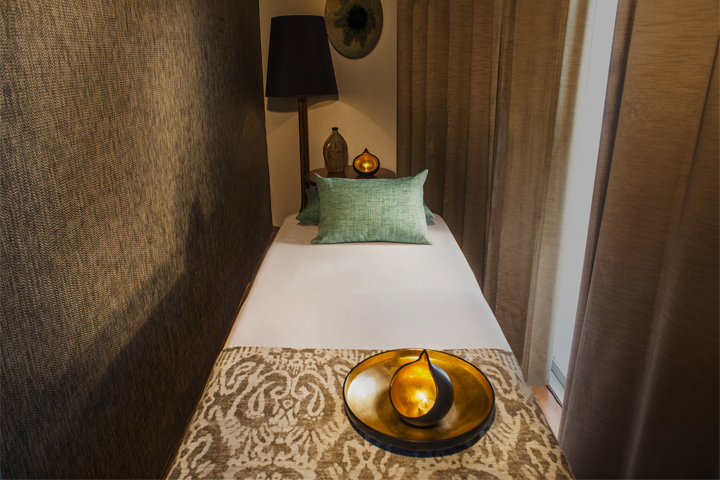
Spa
- Theater/Show Lounge
- Fitness Center
- Pool - Outdoor
- Bars/Lounges
- Elevators
Activities & Services (available for an extra fee)
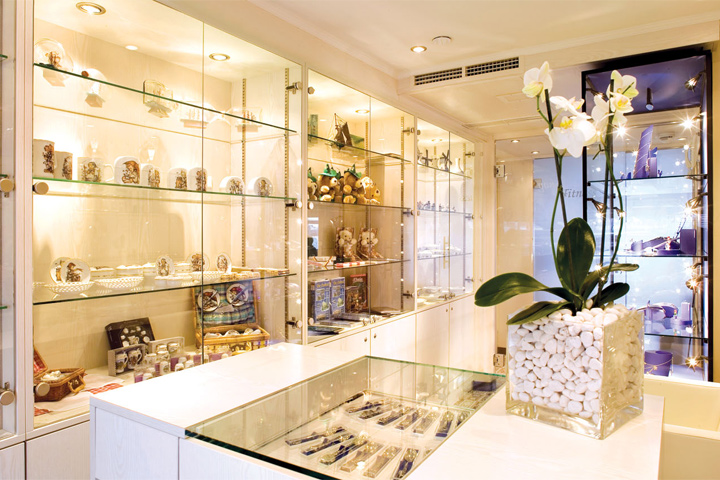
Duty-Free Shops
- Spa Services/Massage
- Dry Cleaning/ Laundry Service
- Duty-Free Shops/Boutiques

Main Dining
Main Dining
Restaurant de Versailles (open seating): This seating option allows you to choose when and with whom you dine. Menus are a blend of classic cuisine with a touch of contemporary elegance, and are created using only the finest and freshest ingredients often brought onboard from local ports of call. You'll be surrounded by the beauty of passing riverbank towns and villages.
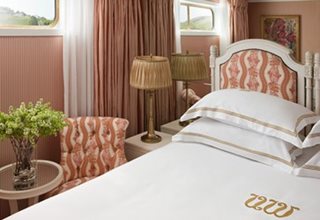
Category: CL
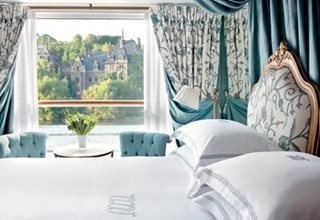
Category: FB
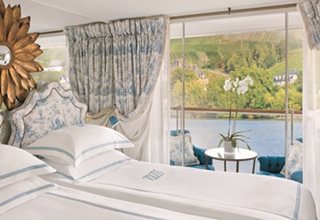
Category: DB
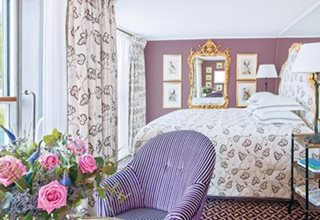
Category: S
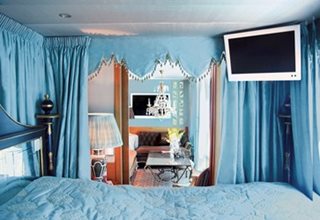
Category: GS

| Symbol | Description |
|---|

- Ship Name: S.S. Antoinette
- Year Built: 2011
- Year Entered Present Fleet: 2011
- Ship Class: Sister ship to River Beatrice
- Maximum Capacity: 164
- Number of Passenger Decks: 4
- Number of Crew: 45
- Officers' Nationality: International
- Ocean-View without Balcony: 20
- Ocean-View with Balcony: 53
- Capacity Based on Double Occupancy: 164
- Country of Registry: Switzerland
- Total Staterooms: 82
- Suites with Balcony: 9
- Crew/Hotel Staff Nationality: International
Costco Member Reviews

Available Dates & Prices
Terms & Conditions
*Price shown is per person based on double occupancy and is valid for select stateroom categories only. Click on the Terms & Conditions link below for details.
**Unlimited beverages include premium wine and premium spirits. Diamond List of wine and spirits is available at an additional cost.
♦Executive Members receive a $50 shipboard credit per person, maximum $100 per stateroom. Executive Member benefit is valid for primary cardholder only. Shipboard credit is per stateroom based on double occupancy. Shipboard credit will be applied to your onboard account. Any unused portion of the credit is nontransferable, nonrefundable and may not be redeemed for cash.
†One Digital Costco Shop Card per room/stateroom, per stay. The exact amount of the Digital Costco Shop Card will be calculated during the booking process. The Digital Costco Shop Card promotion is nontransferable and may not be combined with any other promotion. A Digital Costco Shop Card will arrive by email approximately 10 days after the start of your cruise. Click on the Terms & Conditions link below for additional information.
Ship's registry: Switzerland
Digital Costco Shop Card
Book this vacation or cruise with Costco Travel and receive a Digital Costco Shop Card. The Digital Costco Shop Card is a convenient payment option in our warehouses and on Costco.com.












